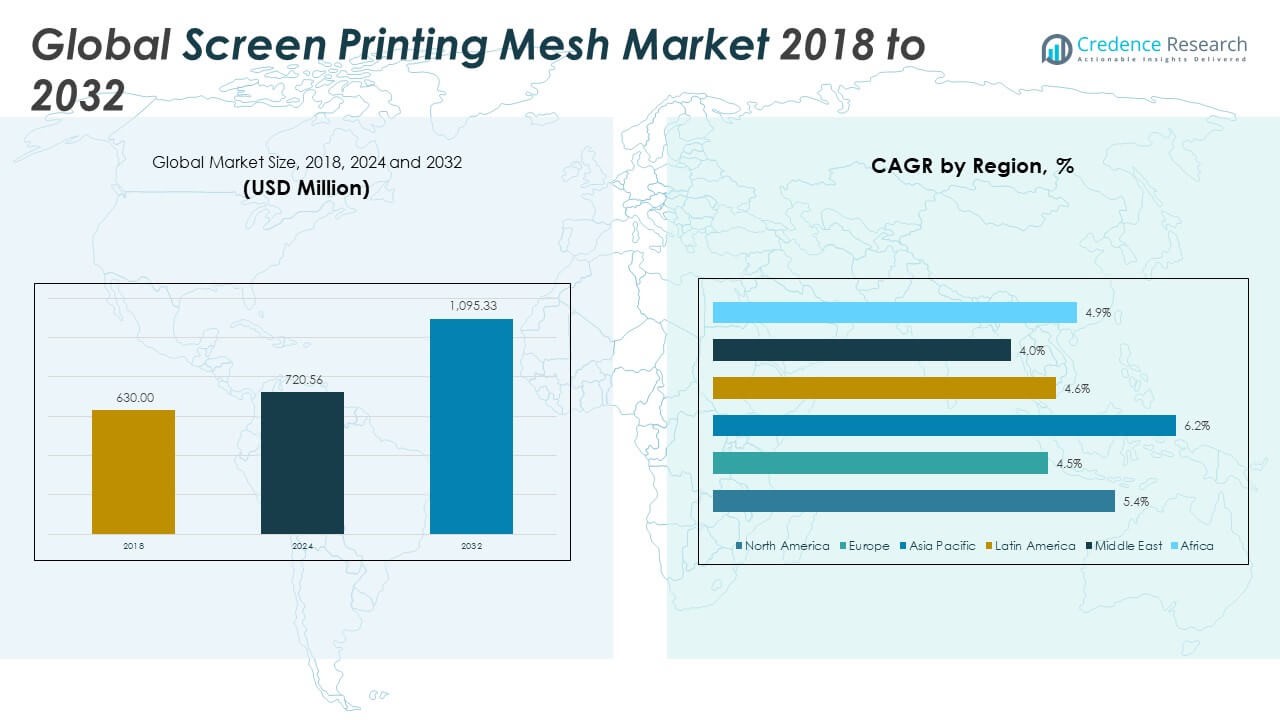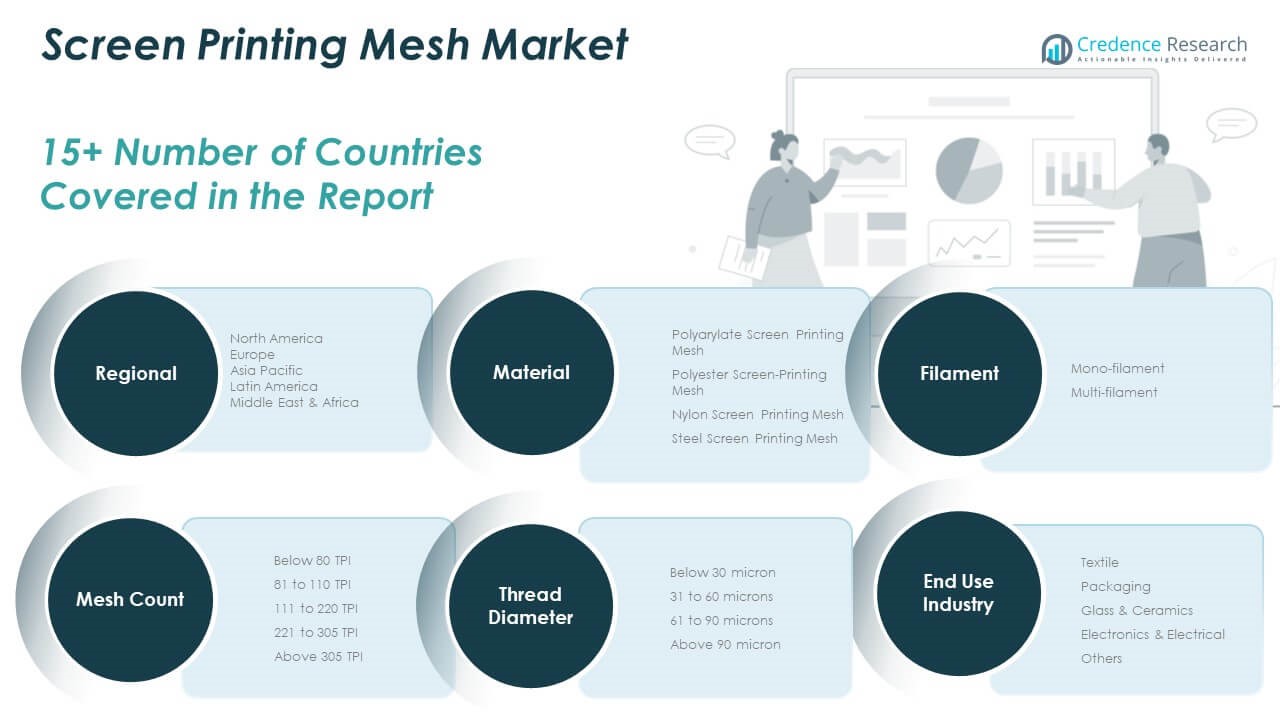CHAPTER NO. 1 : GENESIS OF THE MARKET
1.1 Market Prelude – Introduction & Scope
1.2 The Big Picture – Objectives & Vision
1.3 Strategic Edge – Unique Value Proposition
1.4 Stakeholder Compass – Key Beneficiaries
CHAPTER NO. 2 : EXECUTIVE LENS
2.1 Pulse of the Industry – Market Snapshot
2.2 Growth Arc – Revenue Projections (USD Million)
2.3. Premium Insights – Based on Primary Interviews
CHAPTER NO. 3 : SCREEN PRINTING MESH MARKET FORCES & INDUSTRY PULSE
3.1 Foundations of Change – Market Overview
3.2 Catalysts of Expansion – Key Market Drivers
3.2.1 Momentum Boosters – Growth Triggers
3.2.2 Innovation Fuel – Disruptive Technologies
3.3 Headwinds & Crosswinds – Market Restraints
3.3.1 Regulatory Tides – Compliance Challenges
3.3.2 Economic Frictions – Inflationary Pressures
3.4 Untapped Horizons – Growth Potential & Opportunities
3.5 Strategic Navigation – Industry Frameworks
3.5.1 Market Equilibrium – Porter’s Five Forces
3.5.2 Ecosystem Dynamics – Value Chain Analysis
3.5.3 Macro Forces – PESTEL Breakdown
3.6 Price Trend Analysis
3.6.1 Regional Price Trend
3.6.2 Price Trend by product
CHAPTER NO. 4 : KEY INVESTMENT EPICENTER
4.1 Regional Goldmines – High-Growth Geographies
4.2 Product Frontiers – Lucrative Product Categories
4.3 Filament Sweet Spots – Emerging Demand Segments
CHAPTER NO. 5: REVENUE TRAJECTORY & WEALTH MAPPING
5.1 Momentum Metrics – Forecast & Growth Curves
5.2 Regional Revenue Footprint – Market Share Insights
5.3 Segmental Wealth Flow – Material & Filament Revenue
CHAPTER NO. 6 : TRADE & COMMERCE ANALYSIS
6.1. Import Analysis by Region
6.1.1. Global Screen-Printing Mesh Market Import Revenue By Region
6.2. Export Analysis by Region
6.2.1. Global Screen-Printing Mesh Market Export Revenue By Region
CHAPTER NO. 7 : COMPETITION ANALYSIS
7.1. Company Market Share Analysis
7.1.1. Global Screen-Printing Mesh Market: Company Market Share
7.2. Global Screen-Printing Mesh Market Company Revenue Market Share
7.3. Strategic Developments
7.3.1. Acquisitions & Mergers
7.3.2. New Product Launch
7.3.3. Regional Expansion
7.4. Competitive Dashboard
7.5. Company Assessment Metrics, 2024
CHAPTER NO. 8 : SCREEN-PRINTING MESH MARKET – BY MATERIAL SEGMENT ANALYSIS
8.1. Screen-Printing Mesh Market Overview by Material Segment
8.1.1. Screen-Printing Mesh Market Revenue Share By Material
8.2. Polyarylate Screen Printing Mesh
8.3. Polyester Screen-Printing Mesh
8.4. Nylon Screen Printing Mesh
8.5. Steel Screen Printing Mesh
CHAPTER NO. 9 : SCREEN-PRINTING MESH MARKET – BY FILAMENT SEGMENT ANALYSIS
9.1. Screen-Printing Mesh Market Overview by Filament Segment
9.1.1. Screen-Printing Mesh Market Revenue Share By Filament
9.2. Mono-filament
9.3. Multi-filament
CHAPTER NO. 10 : SCREEN-PRINTING MESH MARKET – BY MESH COUNT SEGMENT ANALYSIS
10.1. Screen-Printing Mesh Market Overview by Mesh Count Segment
10.1.1. Screen-Printing Mesh Market Revenue Share By Mesh Count
10.2. Below 80 TPI
10.3. 81 to 110 TPI
10.4. 111 to 220 TPI
10.5. 221 to 305 TPI
10.6. Above 305 TPI
CHAPTER NO. 11 : SCREEN-PRINTING MESH MARKET – BY THREAD DIAMETER SEGMENT ANALYSIS
11.1. Screen-Printing Mesh Market Overview by Thread Diameter Segment
11.1.1. Screen-Printing Mesh Market Revenue Share By Thread Diameter
11.2. Below 30 microns
11.3. 31 to 60 microns
11.4. 61 to 90 microns
11.5. Above 90 microns
CHAPTER NO. 12 : SCREEN-PRINTING MESH MARKET – BY END-USE INDUSTRY SEGMENT ANALYSIS
12.1. Screen-Printing Mesh Market Overview by End-use Industry Segment
12.1.1. Screen-Printing Mesh Market Revenue Share By End-use Industry
12.2. Textile
12.3. Packaging
12.4. Glass & Ceramics
12.5. Electronics & Electrical
12.6. Others
CHAPTER NO. 13 : SCREEN-PRINTING MESH MARKET – REGIONAL ANALYSIS
13.1. Screen-Printing Mesh Market Overview by Region Segment
13.1.1. Global Screen-Printing Mesh Market Revenue Share By Region
13.1.2. Regions
13.1.3. Global Screen-Printing Mesh Market Revenue By Region
13.1.4. Material
13.1.5. Global Screen-Printing Mesh Market Revenue By Material
13.1.6. Filament
13.1.7. Global Screen-Printing Mesh Market Revenue By Filament
13.1.8. Mesh Count
13.1.9. Global Screen-Printing Mesh Market Revenue By Mesh Count
13.1.10. Thread Diameter
13.1.12. Global Screen-Printing Mesh Market Revenue By Thread Diameter
13.1.13. End-use Industry
13.1.14. Global Screen-Printing Mesh Market Revenue By End-use Industry
CHAPTER NO. 14 : NORTH AMERICA SCREEN-PRINTING MESH MARKET – COUNTRY ANALYSIS
14.1. North America Screen-Printing Mesh Market Overview by Country Segment
14.1.1. North America Screen-Printing Mesh Market Revenue Share By Region
14.2. North America
14.2.1. North America Screen-Printing Mesh Market Revenue By Country
14.2.2. Material
14.2.3. North America Screen-Printing Mesh Market Revenue By Material
14.2.4. Filament
14.2.5. North America Screen-Printing Mesh Market Revenue By Filament
14.2.6. Mesh Count
14.2.7. North America Screen-Printing Mesh Market Revenue By Mesh Count
14.2.8. Thread Diameter
14.2.9. North America Screen-Printing Mesh Market Revenue By Thread Diameter
14.2.10. End-use Industry
14.2.11. North America Screen-Printing Mesh Market Revenue By End-use Industry
14.3. U.S.
14.4. Canada
14.5. Mexico
CHAPTER NO. 15 : EUROPE SCREEN-PRINTING MESH MARKET – COUNTRY ANALYSIS
15.1. Europe Screen-Printing Mesh Market Overview by Country Segment
15.1.1. Europe Screen-Printing Mesh Market Revenue Share By Region
15.2. Europe
15.2.1. Europe Screen-Printing Mesh Market Revenue By Country
15.2.2. Material
15.2.3. Europe Screen-Printing Mesh Market Revenue By Material
15.2.4. Filament
15.2.5. Europe Screen-Printing Mesh Market Revenue By Filament
15.2.6. Mesh Count
15.2.7. Europe Screen-Printing Mesh Market Revenue By Mesh Count
15.2.8. Thread Diameter
15.2.9. Europe Screen-Printing Mesh Market Revenue By Thread Diameter
15.2.10. End-use Industry
15.2.11. Europe Screen-Printing Mesh Market Revenue By End-use Industry
15.3. UK
15.4. France
15.5. Germany
15.6. Italy
15.7. Spain
15.8. Russia
15.9. Rest of Europe
CHAPTER NO. 16 : ASIA PACIFIC SCREEN-PRINTING MESH MARKET – COUNTRY ANALYSIS
16.1. Asia Pacific Screen-Printing Mesh Market Overview by Country Segment
16.1.1. Asia Pacific Screen-Printing Mesh Market Revenue Share By Region
16.2. Asia Pacific
16.2.1. Asia Pacific Screen-Printing Mesh Market Revenue By Country
16.2.2. Material
16.2.3. Asia Pacific Screen-Printing Mesh Market Revenue By Material
16.2.4. Filament
16.2.5. Asia Pacific Screen-Printing Mesh Market Revenue By Filament
16.2.6. Mesh Count
16.2.7. Asia Pacific Screen-Printing Mesh Market Revenue By Mesh Count
16.2.8. Thread Diameter
16.2.9. Asia Pacific Screen-Printing Mesh Market Revenue By Thread Diameter
16.2.10. End-use Industry
16.2.11. Asia Pacific Screen-Printing Mesh Market Revenue By End-use Industry
16.3. China
16.4. Japan
16.5. South Korea
16.6. India
16.7. Australia
16.8. Southeast Asia
16.9. Rest of Asia Pacific
CHAPTER NO. 17 : LATIN AMERICA SCREEN-PRINTING MESH MARKET – COUNTRY ANALYSIS
17.1. Latin America Screen-Printing Mesh Market Overview by Country Segment
17.1.1. Latin America Screen-Printing Mesh Market Revenue Share By Region
17.2. Latin America
17.2.1. Latin America Screen-Printing Mesh Market Revenue By Country
17.2.2. Material
17.2.3. Latin America Screen-Printing Mesh Market Revenue By Material
17.2.4. Filament
17.2.5. Latin America Screen-Printing Mesh Market Revenue By Filament
17.2.6. Mesh Count
17.2.7. Latin America Screen-Printing Mesh Market Revenue By Mesh Count
17.2.8. Thread Diameter
17.2.9. Latin America Screen-Printing Mesh Market Revenue By Thread Diameter
17.2.10. End-use Industry
17.2.11. Latin America Screen-Printing Mesh Market Revenue By End-use Industry
17.3. Brazil
17.4. Argentina
17.5. Rest of Latin America
CHAPTER NO. 18 : MIDDLE EAST SCREEN-PRINTING MESH MARKET – COUNTRY ANALYSIS
18.1. Middle East Screen-Printing Mesh Market Overview by Country Segment
18.1.1. Middle East Screen-Printing Mesh Market Revenue Share By Region
18.2. Middle East
18.2.1. Middle East Screen-Printing Mesh Market Revenue By Country
18.2.2. Material
18.2.3. Middle East Screen-Printing Mesh Market Revenue By Material
18.2.4. Filament
18.2.5. Middle East Screen-Printing Mesh Market Revenue By Filament
18.2.6. Mesh Count
18.2.7. Middle East Screen-Printing Mesh Market Revenue By Mesh Count
18.2.8. Thread Diameter
18.2.9. Middle East Screen-Printing Mesh Market Revenue By Thread Diameter
18.2.10. End-use Industry
18.2.11. Middle East Screen-Printing Mesh Market Revenue By End-use Industry
18.3. GCC Countries
18.4. Israel
18.5. Turkey
18.6. Rest of Middle East
CHAPTER NO. 19 : AFRICA SCREEN-PRINTING MESH MARKET – COUNTRY ANALYSIS
19.1. Africa Screen-Printing Mesh Market Overview by Country Segment
19.1.1. Africa Screen-Printing Mesh Market Revenue Share By Region
19.2. Africa
19.2.1. Africa Screen-Printing Mesh Market Revenue By Country
19.2.2. Material
19.2.3. Africa Screen-Printing Mesh Market Revenue By Material
19.2.4. Filament
19.2.5. Africa Screen-Printing Mesh Market Revenue By Filament
19.2.6. Mesh Count
19.2.7. Africa Screen-Printing Mesh Market Revenue By Mesh Count
19.2.8. Thread Diameter
19.2.9. Africa Screen-Printing Mesh Market Revenue By Thread Diameter
19.2.10. End-use Industry
19.2.11. Africa Screen-Printing Mesh Market Revenue By End-use Industry
19.3. South Africa
19.4. Egypt
19.5. Rest of Africa
CHAPTER NO. 20 : COMPANY PROFILES
20.1. NBC Meshtec
20.1.1. Company Overview
20.1.2. Product Portfolio
20.1.3. Financial Overview
20.1.4. Recent Developments
20.1.5. Growth Strategy
20.1.6. SWOT Analysis
20.2. Asada Mesh
20.3. Nippon Tokushu Fabric
20.4. HEBEI ANPING PRINTING SCREEN CO., LTD
20.5. QINGDAO GREATWALL INDUSTRY CO., LTD
20.6. Shanghai Gold-Up Screen-Printing Facilities Co. Ltd.
20.7. Sefar AG
20.8. Saati SPA
20.9. HAVER & BOECKER OHG
20.10. Weisse & Eschrich GmbH & Co. KG









